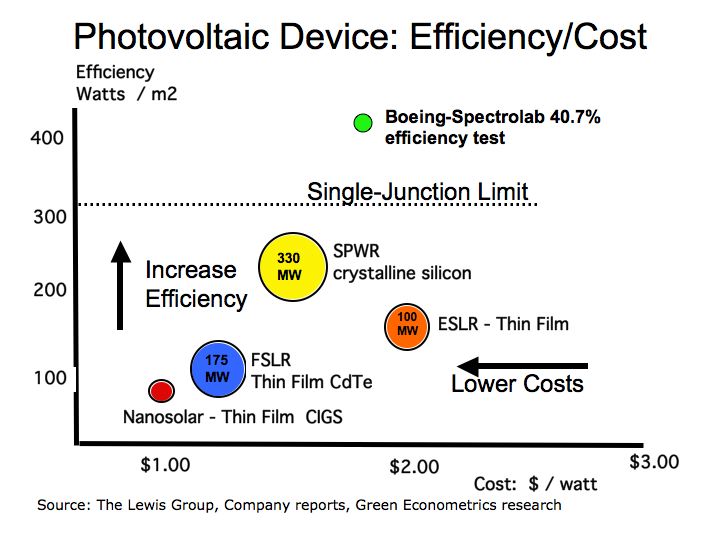Economics of Solar Energy – price parity and efficiency: Are we there yet?
With the Solar Decathlon is taking place in Washington DC today promoting commercially available solar energy technology and oil prices pushing to an all time high of $84/barrel, where are we in terms of cost parity with hydrocarbon fuels. Advances in solar energy technology, lower production costs, and rapidly rising oil costs could bring solar energy into parity with hydrocarbon fuels within five years.
The cost of solar energy remains prohibitively high at about $0.45 per kilowatt-hour (KWH) for an installed system. (a kilowatt-hour equals a 100-watt light in operations for 10 hours and equals 3,412.14 British Thermal Units – BTU) As a reminder, there is significant variance in cost per KWH ($0.23-to-$0.68) because a solar energy system is dependent upon daily available sunlight, which varies from about two hours a day in Alaska to almost six hours in Arizona. Solar energy costs are based on data from solar photovoltaic (PV) supplies SunPower (SPWR) and Sharp Solar.
In comparison to hydrocarbon fuels, one gallon of gasoline has an energy value equal to approximately 125,000 BTUs and cost around $3.00/gallon. The energy value of a gallon of gasoline equates to 36.6 KWH, therefore its price is about $0.08 per KWH. So there is significant disparity between gasoline at $0.08/KWH and solar energy at $0.45.
Fortunately, there are a number of initiatives seeking to improve the economics of solar energy. When we measure the cost of solar energy in dollars per watt we find a complete solar energy systems cost around $8.90/watt. (If we amortize the $8.90/watt over a twenty year expected life of a solar energy system, it amounts to $0.45/KWH) To improve the economic value of solar energy we can lower production costs and/or improve solar efficiency in terms of raising the KWH of electric produced per solar panel.
From the Lewis Group. at Caltech, we learned about several technological approaches to improving solar energy efficiency. Among some of the leading solar technologies are multi-junction semiconductor cells and solar concentrators. In a multi-junction cell, individual cells are made of layers, where each layer captures part of the sunlight passing through the cell. One of the key limits to solar efficiency are the semiconductor band gaps where excess solar energy is lost to heat instead of being converted to electric. Solar concentrators amplify available sunlight and increase the watts per square meter per solar panel.
Last year the Department of Energy reported that solar energy achieved a new record in efficiency performance. The news release, New World Record Achieved in Solar Cell Technology. suggesting that solar concentrators and multi-junction PV cells could surpass the Shockley-Queisser single-junction solar efficiency limit of approximately 31% for single layer solar cell. The multi-junction, concentrator solar cell produced by Boeing-Spectrolab (a Boeing company BA) achieved a world-record conversion efficiency of 40.7% in lab experiments while commercial products operate at 26.5%-to-28.3% efficiency range.
The DOE believes breakthroughs in solar efficiency such as these may lead to systems with an installation cost of only $3 per watt, which translates into a cost of $0.15/KWH. In addition, solar PV cell suppliers are diligently working to reduce production costs. SunPower is targeting a 23% solar efficiency as a goal to reduce its solar energy system cost by 50% by 2012. Semiconductor solar cells benefit from economies of scale, which could reduce cost by 20% for each doubling of production. These solar initiatives should act to reduce solar energy costs.
Meanwhile, as energy costs rise with oil at $84/barrel, the cost of gasoline is expected to increase. If gasoline at the local filling station rises to $6.00/gallon, its cost in KWH jumps to $0.16/KWH. At that price gasoline would be above those achievable through solar energy advancements of $0.15/KWH.
Figure 1 Photovoltaic Device: Efficiency/Cost

With pricing on PV cells falling below $3.00/watt (or $0.15/ kilowatt-hour), solar energy will be close to parity with conventional hydrocarbons. If the cost of gasoline rises to $6.00 a gallon, it would cost $0.16/KWH while current cost of electric is about $0.11/KWH because of the low cost of coal. The bottom line is innovative research initiatives have the potential to deliver disruptive technologies that significantly changes the economics of delivering an energy solutions to all nations.
Further review:
Please see research at California Institute of Technology’s division of Chemical and Chemical Engineering at The Lewis Group.
Imperial College, Jenny Nelson’s Third generation Solar Cells.
DOE’s National Renewable Energy Lab (NREL) Third Generation Solar Photon Conversion (Exceeding the 32% Shockley(Exceeding the 32% Shockley—Queisser Limit)
Solar Energy Market Data Solarbuzz
Related Posts